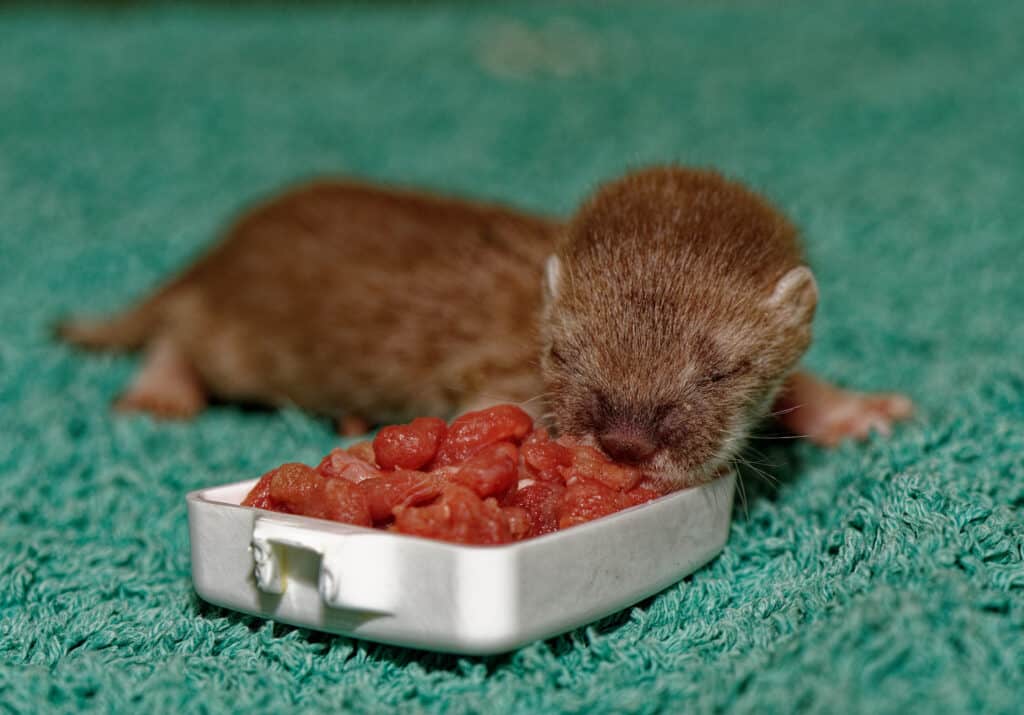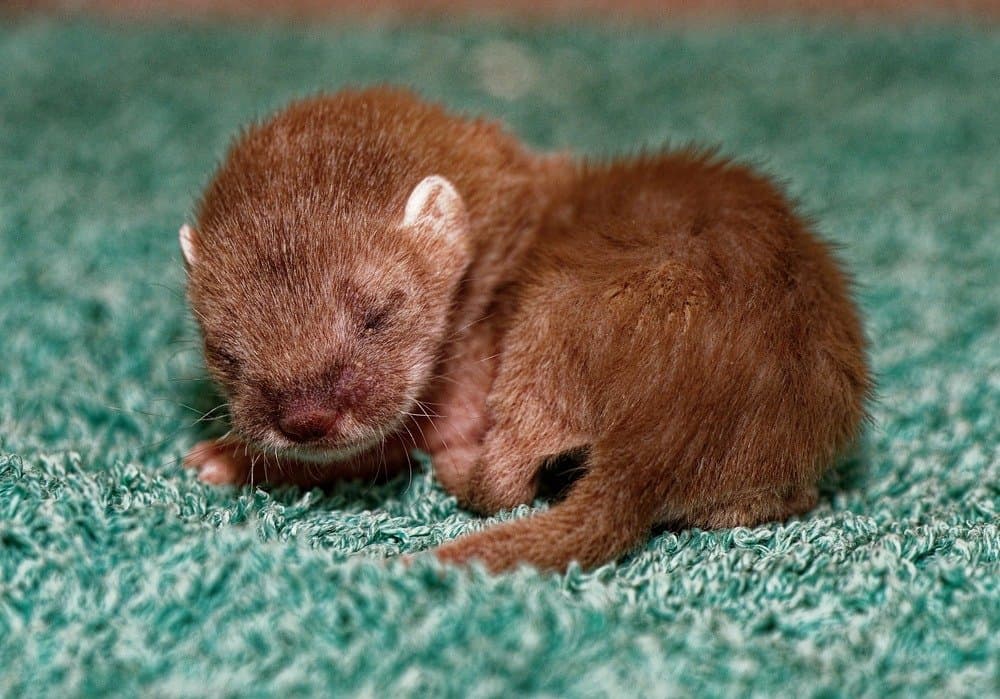When you imagine a baby stoat, you may picture a sleek weasel with an alert expression and quick movements. While this image is generally accurate, stoats are not actually weasels. The confusion is worsened by their alternate name, “short-tailed weasels.” Despite being different species, stoats and weasels belong to the same family, Mustelidae. This family also encompasses other mustelids like ferrets, minks, and otters. Read on to discover eight fascinating facts about baby stoats!
1. Stoat Babies Are Called “Kits”

Baby stoats are called “kits.”
©Colin Seddon/Shutterstock.com
Baby stoats are called “kits,” which is a shortened form of the word “kitten.” Scientists typically use this term to describe the young of cat-sized animals where no other term is applicable. The term also applies to young beavers, foxes, ferrets, and raccoons, among others.
Stoats give birth to five to 12 kits at once. Like many other mammals, stoat kits are completely helpless at birth and must rely on their mother for survival. However, they mature fairly quickly, with their mother weaning them at five to six years of age.
2. Stoat Females Can Become Pregnant While Still Babies
It may be shocking to us as humans, but stoat females can become pregnant while they are still technically babies or kits. This happens as early as two weeks of age while the female kits are still nursing from their mother. Male stoats who enter an adult female’s nest to mate with her may also seize the opportunity to mate with her female kits. The process of delayed implantation applies to female kits as well as adult females; see the next fact to discuss this unique process.
3. Stoat Embryos Stop Developing for Eight to Nine Months
Stoat embryos don’t behave the way embryos in most other mammals do. Though female stoats usually become pregnant between August and October, they don’t give birth until the following spring or even later. This is due to a process called “delayed implantation,” which makes a fertilized embryo pause its development in the womb for eight to nine months.
Delayed implantation involves several steps. After fertilization, the embryo grows into a blastocyst, which is a ball filled with fluid. At this point, it enters embryonic diapause, the stage in which embryonic development pauses for eight to nine months. During this stage, the embryo remains in the uterus instead of implanting into the uterine wall. At some point during the following year, the embryo resumes its normal development. After implantation, it undergoes a gestation period of three to four weeks before the female gives birth.
4. Stoat Babies Have Extra Thick Fur on Their Necks

The fur on the back of the necks of stoat kits is thick and abundant.
©Colin Seddon/Shutterstock.com
Stoat kits don’t have a lot of hair at birth. A layer of thin white fur covers their tiny bodies, except for one place on the back of their necks. There, the fur is thick and abundant. This adaptation enables their mother to easily carry them in her mouth without dropping or hurting them.
This comes in handy when mothers change nests. Many choose to do so every few days to throw predators off their scent. They carry their young in their mouths at astonishing speed, up to 20 miles per hour, to minimize the risk of attacks along the way.
5. Stoat Babies Are Blind and Deaf at Birth
Though many species give birth to blind babies, stoat kits have to remain that way longer than many other animals. They are born with their eyes closed and don’t open them until they reach at least one month of age, sometimes later. Not only are baby stoats blind, but they are also deaf at birth. Until they gain their sight and hearing, they are completely helpless and especially vulnerable to predation. Ironically, later in life, their hearing and eyesight both become keen.
6. Baby Stoats Don’t Just Play for Fun
The internet is rife with pictures and videos of adorable baby stoats playing together. Despite these endearing images, stoat kits don’t roughhouse for the fun of it. On the contrary, it’s a matter of life and death. Baby stoats play to learn survival skills like tackling and holding. Most of their play is noticeably rough and aggressive, in line with the skills they need as adults.
Adult stoats can take on prey four to five times their size. One of their odder hunting tactics involves jumping around frantically in clear sight of their prey. When the prey comes closer to investigate the strange display, the stoat pounces on the closest individual. Without playmates as kits, stoats struggle to refine these kinds of skills and may not be able to feed themselves as adults.
7. Stoat Babies Are Born Without the Black Tip on Their Tails

The black tip on a stoat’s tail helps disguise the rest of the stoat’s body by drawing a predator’s attention away from it.
©Martin Prochazkacz/Shutterstock.com
One way of distinguishing between a stoat and a weasel is the stoat’s black-tipped tail. However, stoats aren’t born with this marking. It takes approximately six weeks for the black tip to appear on a baby stoat’s tail.
The black tip remains even on stoats in colder climates, whose fur lightens in response to the presence of snow. Some scientists have hypothesized that the black tip helps disguise the rest of the stoat’s body by drawing a predator’s attention away from it. Focused on the conspicuous black tail, the predator is likelier to attack it and miss the body entirely. This gives the stoat the chance to escape with its life.
8. Most Baby Stoats Don’t Survive to Adulthood
The mortality rate for baby stoats is high. Though stoats can live as long as four to five years in the wild and up to 10 years in captivity, most individuals only live one or two years. Many stoat kits don’t even make it this long, dying shortly after birth or in the ensuing weeks.
Why do so many stoats die so young? One common cause is a lack of prey. Alternatively, baby stoats may become prey themselves for the likes of snakes, foxes, or large birds. Due to their aggressive nature and their tendency to take on prey larger than themselves, some stoat juveniles also face death due to their own inexperience in hunting.
While baby stoats may look adorable, be careful when approaching a mother with kits. Stoats are bold and aggressive, especially when defending their young. Never try to handle a wild stoat, as they are quick to bite.
Up Next:
- Stoat vs. Weasel: 5 Key Differences
- Stoat vs. Ferret: What Are the Differences?
- Ermine vs. Weasel: 4 Ways They Are Different
The photo featured at the top of this post is © Martin Prochazkacz/Shutterstock.com
Thank you for reading! Have some feedback for us? Contact the AZ Animals editorial team.






